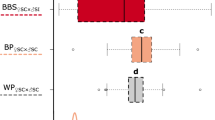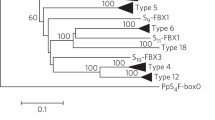Abstract
A series of crosses between a naturally-occurring self-compatible accession ofLycopersicon peruvianum and a closely-related self-incompatible accession were used to demonstrate that the mutation to self-compatibility is located at the S-locus. Progeny of the crosses contain abundant style proteins of about 30 kDa that segregate with the S6and S7-alleles from the SI parent and the Sc-allele from the SC parent. The S6and S7-associated proteins have ribonuclease activity whereas the Sc-associated protein is not an active ribonuclease. This finding indicates that S-RNases are determinants of self-incompatibility in the style and that the ribonuclease activity is essential for their function.
Similar content being viewed by others
References
Ai Y, Kron E, Kao T-h (1991) S-alleles are retained and expressed in a self-compatible cultivar ofPetunia hybrida. Mol Gen Genet 230:353–358
Clarke AE, Newbigin E (1993) Molecular aspects of self-incompatibility in flowering plants. Annu Rev Genet 27:257–279
Dodds PN, Bönig I, Du H, Rödin J, Anderson MA, Newbigin E, Clarke AE (1993) The S-RNase gene ofNicotiana alata is expressed in developing pollen. Plant Cell 5: 1771–1782
Gray JE, McClure BA, Bönig I, Anderson MA, Clarke AE (1991) Action of the style product of the self-incompatibility gene ofNicotiana alata (S-RNase) on in-vitro grown pollen tubes. Plant Cell 3:271–283
Ioerger TR, Clark AG, Kao T-h (1990) Polymorphism at the self-incompatibility locus in Solanaceae predates speciation. Proc Natl Acad Sci USA 87:9732–9735
Jain SK (1976) The evolution of inbreeding in plants. Annu Rev Ecol Syst 10:469–495
Jahnen W, Batterham MP, Clarke AE, Moritz RE, Simpson RJ (1989) Identification, isolation, and N-terminal sequencing of style glycoproteins associated with self-incompatibility inNicotiana alata. Plant Cell 1:493–499
Kawata Y, Sakiyama F, Hayashi F, Kyogoku Y (1990) Identification of two essential histidine residues of ribonuclease T2 fromAspergillis oryzae. Eur J Biochem 187:255–262
Laemmli UE (1970) Cleavage of structural proteins during assembly of the head of bacteriophage T4. Nature 227: 680–685
Maheswaran G, Perryman T, Williams EG (1986) Use of an interspecific hybrid in identifying a new allelic specificity generated at the self-incompatibility locus after inbreeding inLycopersicon peruvianum. Theor Appl Genet. 73:236–245
Martin FW (1968) The behaviour ofLycopersicon incompatibility alleles in an alien genetic milieu. Genetics 60:101–109
Mascarenhas JP (1990) Gene activity during pollen development. Annu Rev Plant Physiol Plant Mol Biol 41: 317–338
Mau S-L, Williams EG, Atkinson A, Anderson MA, Cornish EC, Greco B, Simpson RJ, Kheyr-Pour A, Clarke AE (1986) Style proteins of a wild tomato (Lycopersicon peruvianum) associated with expression of self-incompatibility. Planta 169:184–191
Mau S-L, Anderson MA, Heisler M, Haring V, McClure BA, Clarke AE (1991) Molecular and evolutionary aspects of self-incompatibility in flowering plants. In: Jenkins GI, Schuch W (eds)Mo lecular biology of plant development. Symposia of the Society for Experimental Biology, No. XLV. The Company of Biologists Limited, Cambridge, pp 245–269
Mayo O, Eeach CR (1987) Stability of self-incompatibility systems. Theor Appl Genet 74:789–792
McClure BA, Haring V, Ebert PR, Anderson MA, Simpson RJ, Sakiyama F, Clarke AE (1989) Style self-incompatibility gene prodcts ofNicotiana alata are ribonucleases. Nature 342:955–957
McClure BA, Gray JE, Anderson MA, Clarke AE (1990) Self-incompatibility inNicotiana alata involves degradation of pollen rRNA. Nature 347:757–760
Newbigin E, Anderson MA, Clarke AE (1993) Gametophytic selfincompatibility systems.Plant Cell. 5:1315–1324
Rick CM (1963) Barriers to interbreeding inLycopersicon peruvianum. Evolution 17:216–232
Rick CM (1982a) Genetic relationships between self-incompatibility and floral traits in the tomato species. Biol Zbl 101:185–198
Rick CM (1982b) A new self-compatible wild population ofL. peruvianum. TGC Report 32:43–44
Rick CM, Chetelat RT (1991) The break down of self-incompatibility inLycopersicon hirsutum. In: Hawkes, JG., Lester RN, Nee M. Estrada N (eds) Solanaceae III: taxonomy, chemistry, evolution. Royal Botanic Gardens Kew and Linnean Society of London, pp 253–256
Rivers BA, Bernatzky R, Robinson SJ, Jahnen-Dechent W (1993) Molecular diversity at the self-incompatibility locus is a salient feature in natural populations of wild tomato (Lycopersicon peruvianum). Mol Gen Genet 238:419–427
Sims TL (1993) Genetic regulation of self-incompatibility. Crit Rev Plant Sci 12:129–167
Singh A, Ai Y, Kao T-h (1991) Characterization of ribonuclease activity of three S-allele-associated proteins ofPetunia inflata. Plant Physiol 96:61–68
Taylor IB (1986) Biosystematics of the tomato. In: Atherton JG, Rudich J (eds) The tomato crop. A scientific basis for improvement. Chapman and Hall, London New York, pp 1–34
Thompson RD, Uhrig H, Hermsen JGTh, Salamini F, Kaufmann H (1991) Investigation of a self-compatible mutation inSolanum tuberosum clones inhibiting S-allele activity in pollen differentially. Mol Gen Genet 226:283–288
Tsai D-S, Lee H-S, Post LC, Kreiling KM, Kao T-H (1992) Sequence of an S-protein ofLycopersicon peruvianum and comparison with other solanaceous S-proteins. Sex Plant Reprod 5:256–263
Whitehouse HJK (1951) Multiple-allelomorph incompatibility of pollen and style in the evolution of the angiosperms. Ann Bot New Series 14:198–216
Yen Y, Green PJ (1991) Identification and properties of the major ribonucleases ofArabidopsis thaliana. Plant Physiol 97: 1487–1493
Author information
Authors and Affiliations
Additional information
Communicated by H. Dooner
Rights and permissions
About this article
Cite this article
Kowyama, Y., Kunz, C., Lewis, I. et al. Self-compatibility in aLycopersicon peruvianum variant (LA2157) is associated with a lack of style S-RNase activity. Theoret. Appl. Genetics 88, 859–864 (1994). https://doi.org/10.1007/BF01253997
Received:
Accepted:
Issue Date:
DOI: https://doi.org/10.1007/BF01253997




